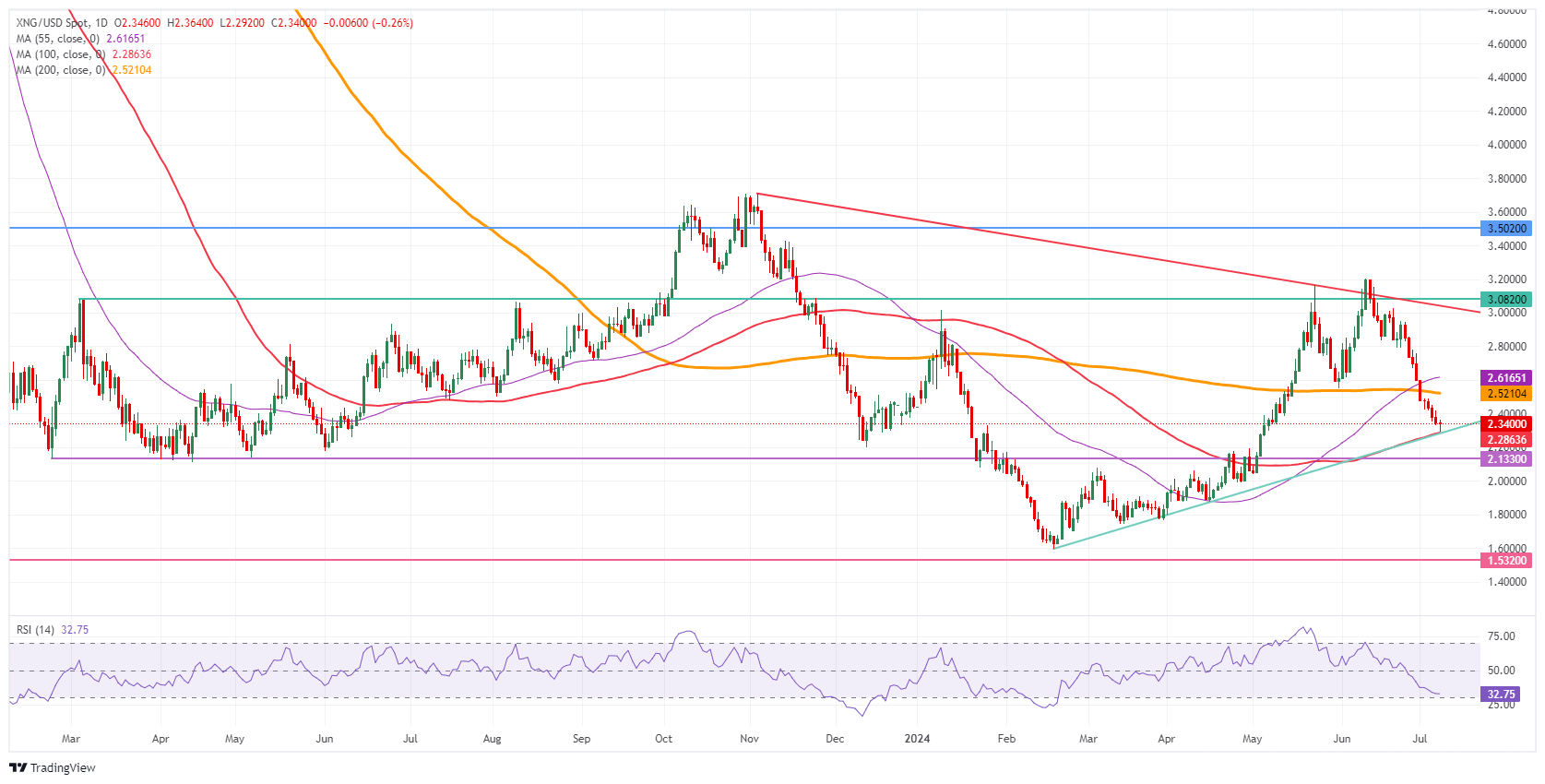Natural Gas unable to snap losing streak with China’s sluggish demand and Slovakia securing non-Russian gas imports

- Natural Gas extends losses early on Monday.
- China’s easing manufacturing activity is cause for concern while Slovakia phases out Russian gas dependence.
- The US Dollar index trades mixed and choppy on the back of the outcome of the French elections.
Natural Gas price (XNG/USD) prints a tenth negative trading day in a row in early European trading hours. The dive came on the back of a surprise victory for the Jean-Luc Mélenchon left-wing coalition New Popular Front in France, outpacing the ruling French President Emmanuel Macron’s centrist Ensemble alliance and the far-right National Rally of Marine Le Pen, putting a government formation in a tight spot with no majority, and no reform plans and additional spending possible. This puts another limit on demand resurgence while China’s demand is fading, with manufacturing being softer and green energy catching up.
Meanwhile, the US Dollar Index (DXY), which tracks the Greenback’s value against six major currencies, is on a very choppy ride on Monday, with traders a bit clueless about which direction to follow. Bond markets are applauding the government stalemate formation in France, with the yield spread between Germany and France retreating, while the US Dollar has been dipping lower, though back to flat now into the European trading session. Looking forward, the DXY might be back into a clear pattern, with the US Consumer Price Index (CPI) for June being the main event this week.
Natural Gas is trading at $2.33 per MMBtu at the time of writing.
Natural Gas news and market movers: Slovakia reports imports
- Additional headline this Monday on Slovakia that is securing near 30% of its gas imports by signing a deal with Poland. This eases and limits the risk for Russian pipepline disruptions and phases out the country’s dependence from Russian gas.
- Recent energy component numbers from China reveal that Hydrogen energy is contributing a more significant than expected part of electricity ahead of the summer. With rising temperatures, the need for electricity increases to keep air conditioning cooling, and normally sees an uptick in Gas consumption. That is being partially offset by hydrogen energy taking its place in the energy pie, according to Bloomberg.
- Gas imports into Europe are not at peak levels and are expected to surge from 18% in 2021 to 43% by 2025-2030, Bloomberg predicts.
- Reuters reports that the Freeport Liquefied Natural Gas (LNG) facility in Texas has successfully ramped down its production so that Storm Beryl can make its passage in the region. Production has been reduced by 86%.
- The National Hurricane Center warns of strong winds and flash flooding as Beryl hits the Texas shore on Monday and is set to head further inland over Arkansas, Tennessee and Missouri in the coming days.
Natural Gas Technical Analysis: Final stretch?
Natural Gas price bounces right off the support level FXStreet mentioned in previous articles at $2.29, with the double trampoline put in place by the 100-day Simple Moving Average (SMA) alongside the green ascending trend line. The bounce seems to be working for now, though any slightest break below $2.29 could see a wave of selling orders. Thus, bullish Gas traders will be trading this bounce with a tight stop-loss trade regime should the double support area not hold.
The 200-day SMA is the first force to reckon with on the upside, near $2.52, closely followed by the 55-day SMA at $2.61. Once back above, the pivotal level near $3.08 (March 6, 2023, high) remains key resistance after its false break last week, which is still 20% away.
On the other hand, the support level, which could mean some buying opportunities, is $2.29, the 100-day SMA that falls in line with the ascending trend line since mid-February. In case that level does not hold as support, look for the pivotal level near $2.13, which has acted as a cap and floor in the past.
Natural Gas: Daily Chart
Natural Gas FAQs
Supply and demand dynamics are a key factor influencing Natural Gas prices, and are themselves influenced by global economic growth, industrial activity, population growth, production levels, and inventories. The weather impacts Natural Gas prices because more Gas is used during cold winters and hot summers for heating and cooling. Competition from other energy sources impacts prices as consumers may switch to cheaper sources. Geopolitical events are factors as exemplified by the war in Ukraine. Government policies relating to extraction, transportation, and environmental issues also impact prices.
The main economic release influencing Natural Gas prices is the weekly inventory bulletin from the Energy Information Administration (EIA), a US government agency that produces US gas market data. The EIA Gas bulletin usually comes out on Thursday at 14:30 GMT, a day after the EIA publishes its weekly Oil bulletin. Economic data from large consumers of Natural Gas can impact supply and demand, the largest of which include China, Germany and Japan. Natural Gas is primarily priced and traded in US Dollars, thus economic releases impacting the US Dollar are also factors.
The US Dollar is the world’s reserve currency and most commodities, including Natural Gas are priced and traded on international markets in US Dollars. As such, the value of the US Dollar is a factor in the price of Natural Gas, because if the Dollar strengthens it means less Dollars are required to buy the same volume of Gas (the price falls), and vice versa if USD strengthens.
